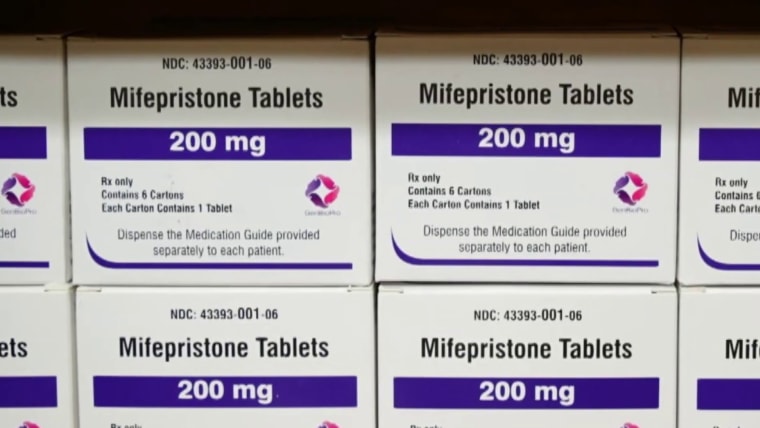On Monday, Trump’s Justice Department slotted into a long-running, right-wing effort to get the abortion drug mifepristone restricted or yanked from the market altogether. Instead of joining forces with the red states challenging the drug, though, it largely picked up where the Biden administration had left off, arguing that the case should be dismissed.
This case, initially brought by anti-abortion doctors who wanted the drug restricted, reached the Supreme Court last summer. The justices ruled that the doctors lacked standing, as they were unable to prove that they were hurt by the Food and Drug Administration’s current set of restrictions on mifepristone. A group of red states tried to take the doctors’ place back at District Judge Matthew Kacsmaryk’s court, creating a glaring jurisdictional issue: None of the states had any connection to north Texas.
“The three Intervenor-Plaintiff States — the States of Missouri, Idaho, and Kansas (“the States”) — do not dispute that their claims have no connection to the Northern District of Texas and that, if the States were to file their own suit in this District, that suit could not proceed due to improper venue,” the Trump DOJ wrote Monday.
If that’s where the brief ended, it’d be a pretty paltry “win” for the abortion rights side. The case was only limping along because Kacsmaryk, a judge known for his extraordinary sympathy toward conservative causes, had control of it; the minute it reached another judge, it would likely be dismissed.
But the administration went further, also poking holes in some of the states’ legal arguments. It raised an eyebrow at the very speculative theory of harm the states were pushing: that an earlier, more restrictive FDA regulatory regime should be put back into place to avoid some possible future conflict with state laws. It also echoed arguments made by the manufacturers of mifepristone that the window has elapsed for challenging the FDA’s 2016 loosening of regulations.
Some legal observers theorize that the administration’s unanticipated stance in the case boils down to its unwavering support for executive power, even when it creates odd bedfellows. It doesn’t want its FDA to be hamstrung — including, perhaps, when it gins up its own reason to restrict mifepristone in the future.
Others think it’s a gambit to create cover while it pursues other avenues of restriction, pointing to a suspect “study” published by a right-wing think tank last week.
“The Abortion Pill Harms Women: Insurance Data Reveals One in Ten Patients Experiences a Serious Adverse Event,” blares the headline of the paper from the Ethics and Public Policy Center.
It bears many of the hallmarks of anti-abortion junk science — no peer review, refusal to publish the underlying data, an ad hoc expansion of definitions (undefined “other, abortion-specific complications” for half the patients they claim experienced severe adverse effects).
EPPC declined to publish its dataset when asked by HuffPost to do so, and told the outlet that the paper was not peer reviewed because “the extensive pro-abortion bias in the peer-review process” creates “no opportunities to publish peer-reviewed analysis that offer major substantive critiques of the abortion pill or abortion.”
See here and here for some background. Slate also covers this.
Missouri, Kansas, and Idaho may be making ridiculous assertions. But what does it mean that the Trump administration is pointing this out? Is it a sign that Trump will defend the status quo on mifepristone and keep his promise to leave the states alone when it comes to abortion?
Probably not. One of the most striking features of the brief is that it says nothing about the merits of the states’ arguments about mifepristone and the Comstock Act. Compare this with similar filings from the Biden administration, which went into painstaking detail about the Comstock Act and the FDA’s authority.
None of this is missing from the Trump administration’s brief by accident. Trump wants to leave himself room to maneuver on mifepristone. His problem with the attorneys general isn’t necessarily that the two groups of Republicans are on different sides when it comes to the drug. It may simply be that Trump wants to control if, or when, he does something on the issue. He doesn’t want to be pushed around by the anti-abortion movement or its allies in the states.
There’s another possibility too—one that Trump could have learned from the 2024 election. During his first term, the anti-abortion movement scored its biggest win in more than half a century, when the president was able to reshape the Supreme Court with three new appointments who would eventually be critical to overturning Roe v. Wade. And yet that fact—and the tremendous unpopularity of the court’s decision in Dobbs v. Jackson Women’s Health Organization—didn’t stop Trump from winning a second term. It seemed he’d found a perfect formula: shifting blame to the courts, then claiming he wouldn’t change the status quo on his own. Cases about mifepristone are already in the pipeline—the Missouri suit is just one example. If passing the buck to SCOTUS worked once before, Trump might be hoping he can do the same with abortion pills.
We don’t know what will happen in this case, or others on mifepristone. The bottom line is that Trump isn’t defending abortion pills. He’s defending his own power to control what happens to them.
Trying to understand what Trump is thinking is a losing game. But we do need to think critically about what he and his minions actually do, so we have some hope of anticipating what might come next. Whatever they’re doing here, it’s not because they believe in mifepristone and the need for women to have access to it. Jessica Valenti has more.


Trump’s tariff made my truck worth more.
Fireworks will be more expensive, making it a quieter 4th of July.
On the negative side, my grocery prices keep going up.